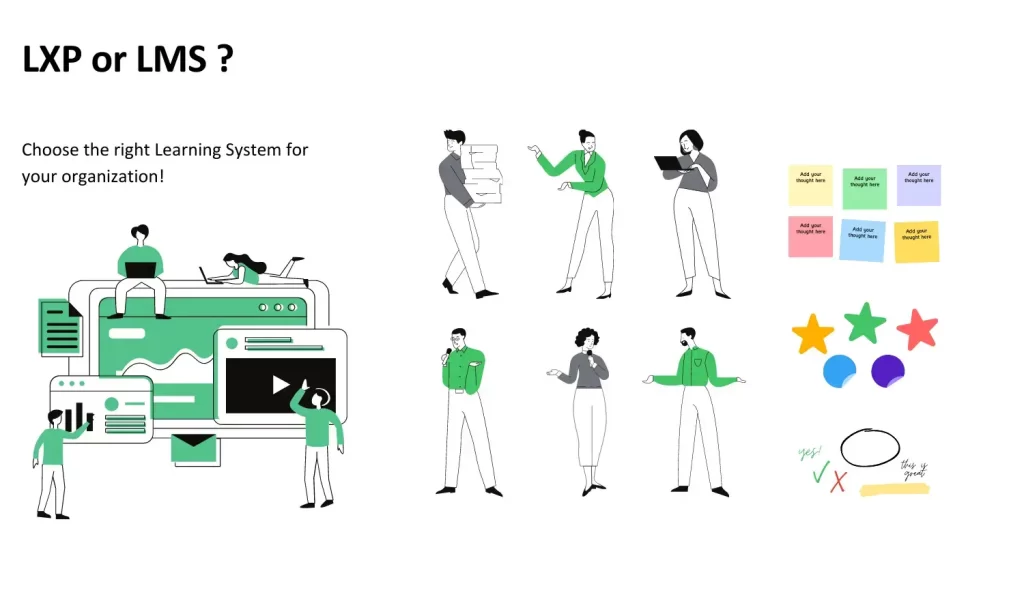

I. Understanding Learning Experience Platforms (LXPs):
A. Learner-centric approach:
B. Social, Community and collaborative features:
Peer-to-peer learning: LXPs foster a social learning environment by facilitating peer-to-peer learning experiences. Through features like discussion forums, community networking (teams in an org), and knowledge sharing, learners can connect with their peers, collaborate on projects, and exchange valuable insights and perspectives.
Social networking and knowledge sharing: LXPs often incorporate social networking features that encourage learners to interact, build communities, and share their knowledge and experiences. This enhances engagement and encourages collaborative learning.
Discussion forums and community engagement: LXPs provide platforms for learners to participate in discussions, ask questions, and seek assistance from their peers. These interactive features promote a sense of community and allow learners to learn from one another.
C. Informal learning support:
Flexibility and exploration: LXPs emphasizes informal learning experiences, similar to their eperiences on social media etc.., offering learners the flexibility to explore and discover knowledge at their own pace. This promotes motivation, curiosity, autonomy, and continuous learning beyond traditional structured courses.
User-generated content: LXPs often enable learners to create and share their own content, such as blog posts, videos, or presentations. This user-generated content fosters collaboration, peer feedback, and the exchange of diverse perspectives.
Content creation and sharing tools: LXPs provide intuitive authoring tools and content creation features that allow subject matter experts and learners to develop and share their own learning resources. This encourages active participation and knowledge sharing within the learning community.
D. Personalized Learning Path
Learner Profiling: To create personalized learning paths, LXPs start by building learner profiles. These profiles capture information about learners’ skills, knowledge levels, learning preferences, job roles, and any specific learning objectives they might have. The platform collects this data through self-assessment tools, pre-assessments, previous course completion records, or through direct inputs from learners.
Learning Recommendations: Based on the learner profiles, LXPs use intelligent algorithms and data analysis to generate targeted learning recommendations. These recommendations suggest specific courses, modules, resources, or learning activities that align with the learner’s goals and interests. The recommendations consider factors like relevance, difficulty level, learning style, and the learner’s previous interactions with the platform.
Adaptive Content Delivery: LXPs employ adaptive content delivery mechanisms to present learning materials in a manner that matches the learner’s proficiency level and preferences. The platform adapts the content based on the learner’s progress, ensuring that they are neither overwhelmed nor bored. For example, if a learner demonstrates preferences of learning in a specific format, the LXP can suggest to convert the existing contents into a format they prefer to learn from.
II. Exploring Learning Management Systems (LMSs):
A. Administrative functionality:
Course creation and management: LMS platforms primarily focus on administrative tasks related to course creation, management, and delivery. They provide instructors with tools to create and organize learning content, set up course structures, and manage learner enrollment.
Learner tracking and reporting: LMSs offer robust tracking and reporting capabilities to monitor learners’ progress, completion rates, and performance. Instructors and administrators can generate reports to assess the effectiveness of courses and identify areas for improvement.
Data management and analytics: LMSs collect and store vast amounts of learner data, including course enrollment, completion records, and assessment results. They leverage data analytics to gain insights into learner behavior, preferences, and overall performance.
B. Structured content delivery:
Slideshows, quizzes, and assessments: LMS platforms facilitate the creation and delivery of structured learning content such as slideshows, quizzes, and assessments. Instructors can design interactive quizzes and assessments to gauge learners’ understanding and provide immediate feedback.
Progress tracking and grading: LMSs enable instructors to track learners’ progress throughout a course, monitor their completion rates, and assign grades or certifications based on their performance. Learners can view their progress and grades, facilitating self-assessment and goal setting.
Instructor-led training support: LMS platforms often incorporate features for managing instructor-led training sessions, including scheduling, attendance tracking, and resource allocation. This is particularly useful for organizations that combine e-learning with traditional classroom-based training.
C. Compliance and certification tracking:
Regulatory training management: LMSs provide functionalities to manage compliance training, ensuring employees receive the necessary training to meet regulatory requirements and industry standards. These platforms facilitate tracking and reporting of compliance-related courses and certifications.
Certification tracking and reminders: LMS platforms assist in managing certification programs by tracking learners’ progress toward obtaining certifications and sending reminders for renewal or further training. This ensures employees maintain their professional certifications and credentials.
Compliance reporting and audits: LMSs generate reports and maintain documentation to demonstrate compliance with regulatory standards. These platforms help organizations conduct internal audits and provide evidence of compliance during external audits.